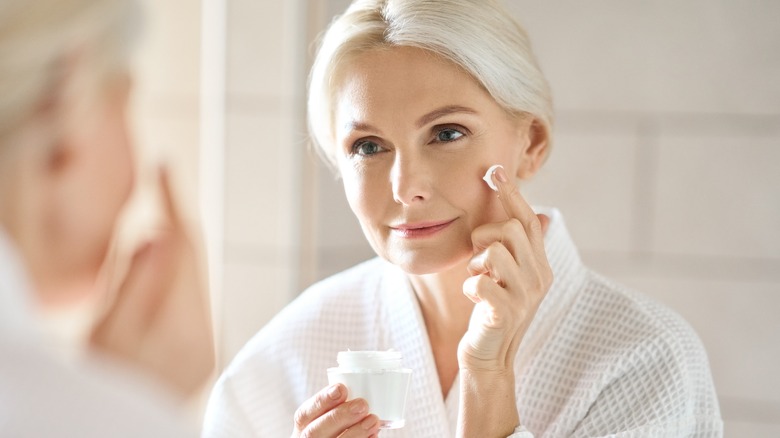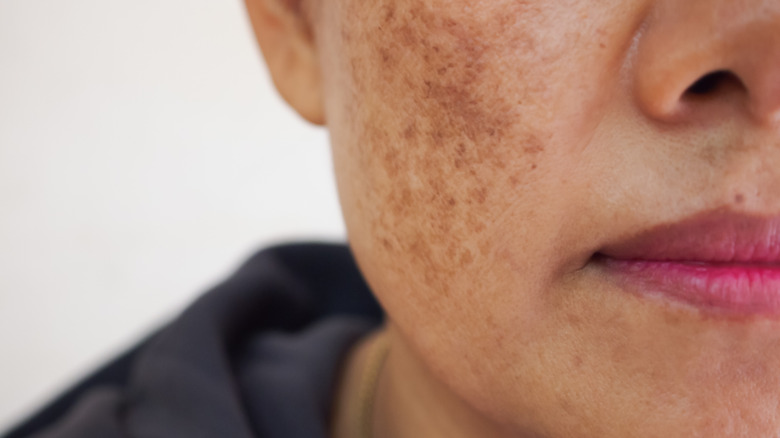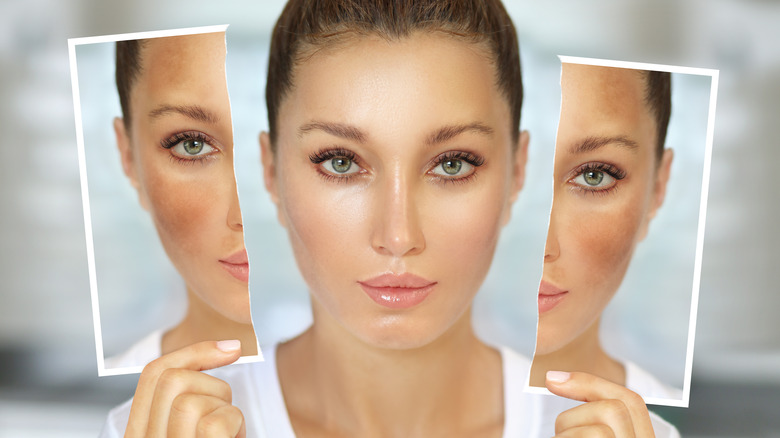Hyperpigmentation Vs. Melasma: What's The Real Difference?
We've all been there before. Spending time in front of the mirror, closely examining those dark patches on our faces. Deep down, we know that excellent skincare regimes and filters create the looks online that we're supposed to be jealous of, but we still can't help but wish we could get rid of these spots too. But do you know what these spots are?
Are they melasma or hyperpigmentation? Is there any real difference? Many people use the terms interchangeably, assuming they're the same. They look and feel the same, so they should be the same, right? And if they are the same, shouldn't their treatment also be the same?
If you have consistently tried to treat your dark spots but to no avail, you need to keep reading. Unfortunately, you might have been caught amid controversy and misinformation regarding the real difference between the two. So, let's dive into the specifics of each one, clear out the debate, and set the record straight once and for all.
What is hyperpigmentation?
Hyperpigmentation is a broad term used to describe discoloration on the skin, frequently in the form of abnormally dark patches. Melanocytes are the cells on our skin responsible for the production of melanin. Melanin is a natural skin pigment, and genetic factors determine the amount of melanin our cells produce. Like everything in genetics, melanin production varies from person to person, accounting for the different skin colors worldwide: the more melanin your body produces, the darker your skin and hair color. However, even though we are genetically programmed to have a certain amount of melanin on our skin, the melanocyte-stimulating hormone (MSH) will sometimes trigger the melanocytes to produce more melanin than usual. This over-production results in hyperpigmentation manifested in dark spots and discoloration.
As Columbia Skin Clinic explains, hyperpigmentation is the general umbrella term covering all dark spots on the skin resulting from excessive melanin production. However, while all hyperpigmented marks result from our hard-working melanocytes working too hard, the triggers may vary. Several factors come into play to determine the type of hyperpigmentation one gets. According to Healthline, the broad umbrella of hyperpigmentation includes three distinct sub-types: primary pigmentary disorders, sun-induced hyperpigmentation, and post-inflammatory hyperpigmentation. Meanwhile, melasma is a primary pigmentary disorder, so while all melasma is hyperpigmentation, not all hyperpigmentation is melasma.
Melasma (primary pigmentation disorder)
The word melasma derives from the Greek word "melas," literally meaning "black." So, as the name suggests, melasma describes light brown, dark brown, or bluish-gray spots on one's cheeks, upper lip, and forehead. As opposed to other post-inflammatory or sun-induced hyperpigmentation, the American Academy of Dermatology Association points out that melasma, while noticeable, will not cause your skin to itch or have any underlying pimples or scars.
While debilitating to one's self-esteem, melasma is harmless and very common. A study published in the Journal of the American Academy of Dermatology, suggests that more than 5 million Americans are affected by it. According to the Cleveland Clinic, 90% of those who get melasma are women. This staggering difference between the prevalence of men and women is due to female reproductive hormones. Estrogen levels stimulate our melanocytes to overproduce melanin. Consequently, pregnant women or women on oral contraceptives are more at risk of developing melasma. Since pregnant women get melasma more than anyone else, the disorder has been dubbed "pregnancy's mask."
Genetics are crucial in developing melasma. Even though the primary trigger for melasma is hormonal changes, exposure to the sun will exacerbate the spots, especially in men and women who tan easily. Moreover, Kirsch Dermatology explains that melasma can be hereditary, as women whose family members have it are also more prone to have it.
Sun-induced hyperpigmentation
Sun-induced hyperpigmentation, as the name suggests, is caused by sun exposure. According to the Mayo Clinic, when exposed to the sun, our skin tries to protect itself by increasing the production of melanin, which gives us the sunkissed tanning allure during the summer we crave for. However, without proper protection and due to consistent sun exposure, uneven production of melanin may be triggered, which results in dark spots. Since our face and neck are more frequently exposed to those harmful UV rays, sun-induced hyperpigmentation appears on the skin. Unfortunately, once these dark spots have developed, further sun exposure can make the dark areas even darker, per Eucerin.
Sun-induced hyperpigmentation is also commonly referred to as "age spots" or "liver spots" and is more prevalent in men and women over 40. As we age, significant changes happen to our skin. As Medline Plus explains, the number of melanin-producing cells (the melanocytes) decreases with age. However, the remaining ones increase in size, and their distribution becomes more specific. So, as the sun triggers excess melanin protection, the pigment finds its way to more concentrated areas of our skin, specifically the areas where the remaining enlarged melanocytes exist.
Post-inflammatory hyperpigmentation
An article published in StatPearls describes post-inflammatory hyperpigmentation as a common skin disorder resulting from skin inflammation or injury manifesting as dark spots across the face. Skin inflammation is typically caused by acne, atopic dermatitis (eczema), and impetigo (a bacterial infection of the skin, such as staphylococcus). While post-inflammatory hyperpigmentation is not permanent, it may take several weeks or months to resolve, per Skinsight. Moreover, DermNet states that hyperpigmentation may persist longer in darker-skinned individuals than lighter-skinned ones.
But how does inflammation result in dark spots? DermNet describes the process in the basal layer of our skin and the epidermis. Skin injuries and inflammation in the epidermis trigger a reaction in the melanocytes stimulating increased melanin production and pigment transference to the surface of our skin. However, the dark patches only appear on the skin (at the site of the original injury) after the infection has healed. The spots may vary from light brown to black, and as with sun-induced hyperpigmentation, sun exposure exacerbates the spots turning them even darker.
Treating melasma
Melasma, sun-induced hyperpigmentation, or post-inflammatory hyperpigmentation? Since they all manifest in similar dark spots on the face, it can be challenging to distinguish between each type. However, knowing which category your dark patches fall under is crucial so you can choose the appropriate treatment, restore your skin's tone, and even out the excess pigmentation. In addition, knowing the underlying cause of your skin's discoloration will help you determine whether your dark patches are hormone-triggered (melasma), sun-induced, or the result of acne and inflammation.
Melasma is primarily triggered by estrogen levels in the body due to medication and hormonal changes during pregnancy. It is, therefore, more challenging to treat than the other two hyperpigmentation types, per the Columbia Skin Clinic. Consequently, opting for non-estrogen-based birth control could improve the melasma outbreak. However, the switch should only be made after professional advice from your gynecologist and dermatologist so that your reproductive goals can align with your skin needs. Another option for treating your melasma spots is brightening creams that include glycolic acid, vitamin C, retinol, azelaic acid, kojic acid, niacinamide, and cysteamine acid (via Harvard Health Publishing). These creams work by reducing excess blood vessels in the skin and, therefore, also minimize pigment production, treat inflammation, and improve melasma spots.
Topicals that include hydroquinone are also very effective but should only be cautiously treated due to potential side effects, according to Kirsch Dermatology. Dr. Michelle Green points out that chemical peels are highly efficient in combating persistent cases of melasma.
Treating sun-induced hyperpigmentation and post-inflammatory hyperpigmentation
Post-inflammatory hyperpigmentation is best treated by attacking the underlying cause rather than treating the after-effect. Since this type of hyperpigmentation occurs after inflammation caused by acne, treating the primary cause is paramount. The Mayo Clinic indicates that the best acne treatment is prescription topicals, including retinoid, azelaic, and salicylic acid. Oral medication (such as oral contraceptives, anti-androgen agents, isotretinoin, and antibiotics) may also be a choice. Persistent acne cases can be treated with light therapy, chemical peel, and steroid injection.
Protecting your skin from harmless UV rays using a high-SPF cream is the best way to combat that sun-induced hyperpigmentation. However, once these "age spots" have appeared on your skin, sun creams will not remedy the problem but can only prevent it from exacerbating. Treatment options include prescription or over-the-counter topicals that contain azelaic acid, corticosteroids, kojic acid, glycolic acid, tretinoin, vitamin C, and vitamin B3. Other, more aggressive options include chemical peels, laser skin resurfacing, pigmented lesion laser, and cryotherapy, per the Cleveland Clinic.
Beautiful, clear skin is a desirable attribute; unfortunately, dark spots on the face can be debilitating to one's self-esteem. However, there is a way to brighten these spots and even out your skin's tone if you distinguish what type of "dark spots" you have. In addition, knowing the real difference between hyperpigmentation and melasma will help you choose the best treatment to combat your skin's discoloration, so you can manifest and achieve the skin of your dreams.






